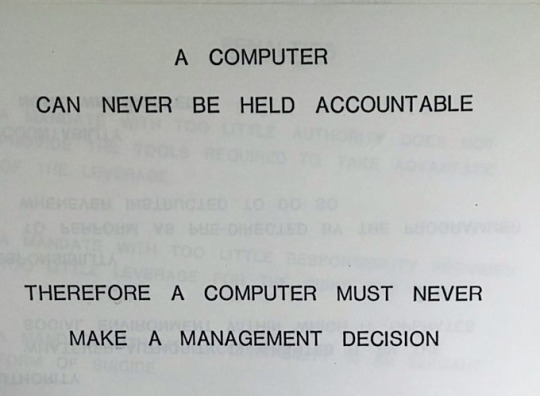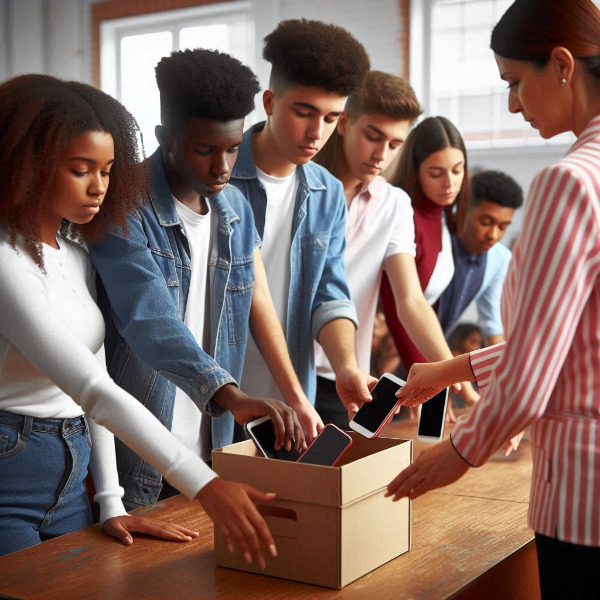Computers (and AI) Are Not Managers

Internal IBM document, 1979 (via Fabricio Teixeira)
I saw the quote pictured above that goes back to 1979 when artificial intelligence wasn't part of the conversation. "A computer must never make a management decision," said an internal document at the big computer player of that time, IBM. The why of that statement is because a computer can't be held accountable.
Is the same thing true concerning artificial intelligence 46 years later?
I suspect that AI is currently being used by management to analyze data, identify trends, and even offer recommendations. But I sense there is still the feeling that it should complement, not replace, human leadership.
Why should AI be trusted in a limited way on certain aspects of decision-making?
One reason that goes back at least 46 years is that it lacks "emotional intelligence." Emotional intelligence (EI or EQ) is about balancing emotions and reasoning to make thoughtful decisions, foster meaningful relationships, and navigate social complexities. Management decisions often require a deep understanding of human emotions, workplace dynamics, and ethical considerations — all things AI can't fully grasp or replicate.
Because AI relies on data and patterns and human management often involves unique situations where there might not be clear precedents or data points, many decisions require creativity and empathy.
Considering that 1979 statement, since management decisions can have far-reaching consequences, humans are ultimately accountable for these decisions. Relying on AI alone could raise questions about responsibility when things go wrong. Who is responsible - the person who used the AI, trained the AI or the AI itself? Obviously, we can't reprimand or fire AI, though we could change the AI we use, and revisions can be made to the AI itself to correct for whatever went wrong.
AI systems can unintentionally inherit biases from the data they're trained on. Without proper oversight, this could lead to unfair or unethical decisions. Of course, bias is a part of human decisions and management too.
Management at some levels involves setting long-term visions and values for an organization. THis goes beyond the realm of pure logic and data, requiring imagination, purpose, and human judgment.
So, can AI handle any management decisions in 2025? I asked several AI chatbots that question. (Realizing that AI might have a bias in favor of AI.) Here is a summary of the possibilities given:
Resource Allocation: AI can optimize workflows, assign resources, and balance workloads based on performance metrics and project timelines.
Hiring and Recruitment: AI tools can screen résumés, rank candidates, and even conduct initial video interviews by analyzing speech patterns and keywords.
Performance Analysis: By processing large datasets, AI can identify performance trends, suggest areas for improvement, and even predict future outcomes.
Financial Decisions: AI systems can create accurate budget forecasts, detect anomalies in spending, and provide investment recommendations based on market trends.
Inventory and Supply Chain: AI can track inventory levels, predict demand, and suggest restocking schedules to reduce waste and costs.
Customer Management: AI chatbots and recommendation engines can handle customer queries, analyze satisfaction levels, and identify patterns in customer feedback.
Risk Assessment: AI can evaluate risks associated with projects, contracts, or business decisions by analyzing historical data and current market conditions.
As I write this in March 2025, the news is full of stories of DOGE and Elon Musk's team using AI for things like reviewing email responses from employees, and wanting to use more AI to replace workers and "improve efficiency." AI for management is an area that will be more and more in the news and will be a controversial topic for years to come. I won't be around in another 46 years to write the next article about this, but I have the feeling that the question of whether or not AI belongs in management may be a moot point by then.
 Ghost students, as their name implies, aren’t real people. They are not spectral visions. Had you asked me earlier to define the term, I would have said it is a way to describe a student who is enrolled in a college or university but does not actively participate in classes or academic activities. However, these new ghosts are aliases or stolen identities used by scammers and the bots they deploy to get accepted to a college, but not for the purpose of attending classes or earning a degree. Why? What's the scam?
Ghost students, as their name implies, aren’t real people. They are not spectral visions. Had you asked me earlier to define the term, I would have said it is a way to describe a student who is enrolled in a college or university but does not actively participate in classes or academic activities. However, these new ghosts are aliases or stolen identities used by scammers and the bots they deploy to get accepted to a college, but not for the purpose of attending classes or earning a degree. Why? What's the scam?
